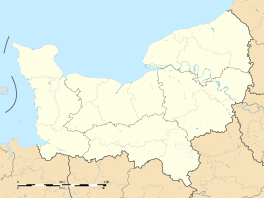Landepéreuse
| Landepéreuse | |
|---|---|
 |
|
| Coordinates: 49°00′19″N 0°38′21″E / 49.0053°N 0.6392°ECoordinates: 49°00′19″N 0°38′21″E / 49.0053°N 0.6392°E | |
| Country | France |
| Region | Normandy |
| Department | Eure |
| Arrondissement | Bernay |
| Canton | Bernay |
| Government | |
| • Mayor (2008–2014) | Agnès Van Den Driessche |
| Area1 | 8.92 km2 (3.44 sq mi) |
| Population (2008)2 | 304 |
| • Density | 34/km2 (88/sq mi) |
| Time zone | CET (UTC+1) |
| • Summer (DST) | CEST (UTC+2) |
| INSEE/Postal code | 27362 /27410 |
| Elevation | 139–192 m (456–630 ft) (avg. 188 m or 617 ft) |
|
1 French Land Register data, which excludes lakes, ponds, glaciers > 1 km² (0.386 sq mi or 247 acres) and river estuaries. 2Population without double counting: residents of multiple communes (e.g., students and military personnel) only counted once. |
|
1 French Land Register data, which excludes lakes, ponds, glaciers > 1 km² (0.386 sq mi or 247 acres) and river estuaries.
Landepéreuse is a former commune in the Eure department in Normandy in northern France. On 1 January 2016, it was merged into the new commune of Mesnil-en-Ouche.
The origin of the name of Landepereuse is easy to find. It derives of the Norman way to pronounce "lande pierreuse" (stony land). The word "lande" comes from Gallic and indicates a dry ground where just few plants grow. Stony is due to the abundance and the size of the stones, sometimes multi metric that are presents in abundance. So this commune did not have been a paradise for the first inhabitants: it was probably difficult to clear and to cultivate at this time when tractors did not exist and metal or iron tools were expensive and rare.
Landepéreuse is a small rural village of Pays d'Ouche located in the south western Eure, in Normandy. Its surface is 892 ha. With uneven maximum of 48 m (altitude ranging between 187 m in the South-West and 139 m in the North-East; town hall at 170 m), this commune slightly undulating, is representative of the territories of Pays d'Ouche who announce already the hills of the Perche country in the south and the Pays d'Auge to a few kilometres in the West. It is constituted of fields, pastures, orchards and woods. These are sometimes separated by hedges, in which the principal species are: Hawthorn, the blackthorn (Sloe). The territory of the commune is crossed by two dry valleys.
Regularly, each year, during strong rain, these two valleys run during few hours to few days (see below the longest valley in January 2008). During the important wet episode in the beginning of 2001 (floods in the Somme), those more in the east ran during a few months.
The geological basement of the commun consists of the geological strates commonly encountered in the Paris Bassin ("o.b..") from the latter primary to the Holocene. Only rare rocks and formations are, or have been accessible to humans. The oldest are of upper Cretaceous.
They are formed of marly chalk exploited formerly in underground quarries, for a long time abandoned. We can see in the landscape, the old fallen down wells access and the cave-in, locally known as bétous (or boitous): (bétoire s in the French version) (see left side, the geological map).
...
Wikipedia


